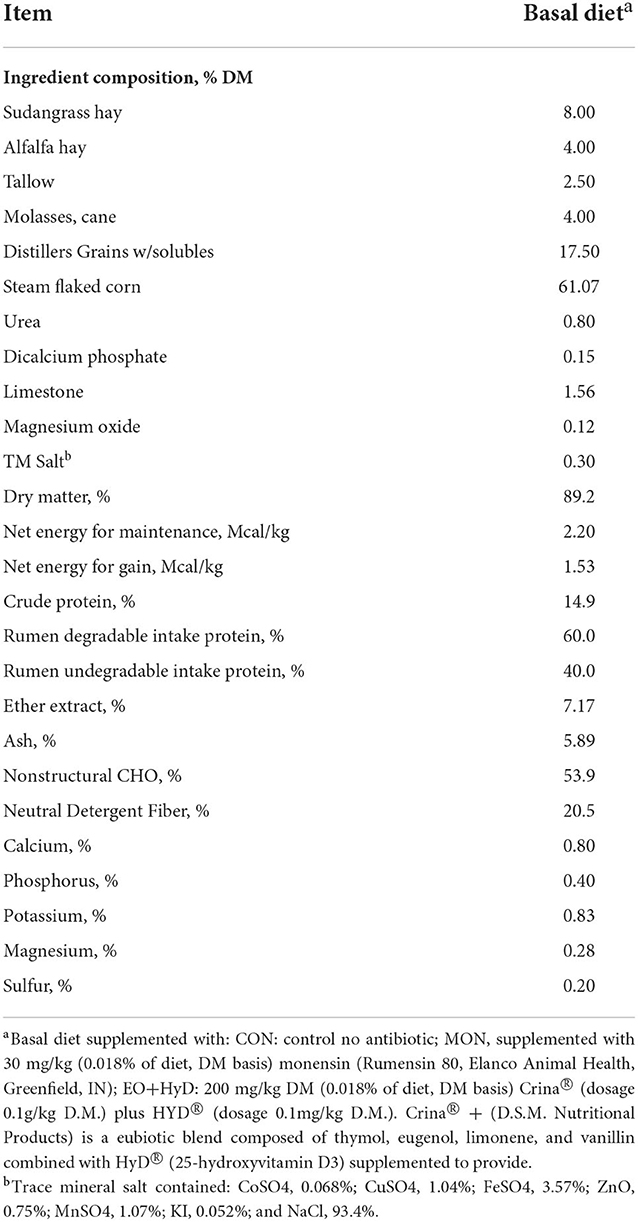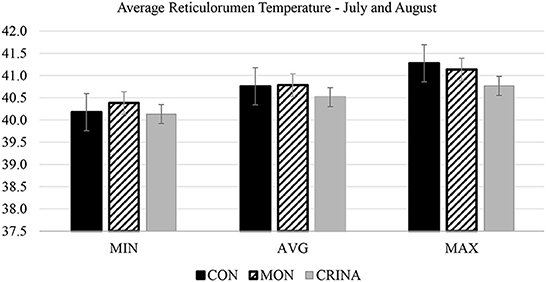- 1Cooperative Extension, Division of Agriculture and Natural Resources, University of California, Holtville, Holtville, CA, United States
- 2Department of Animal Science, University of California, Davis, Davis, CA, United States
Bans on the use of ionophores in several regions of the world has led to a need to identify alternative feed additivies to be added in cattle diets. Essential oil blends have been identified as a potential alternative to ionophores in feedlot diets. The objective of this study was to evaluate the effects of a supplemental a blend of essential oils and 25-hydroxyvitamin D3 on growth performance, energetic efficiency, and carcass characteristics in calf-fed Holstein steers. Ninety Holstein steer calves (123 ± 7 kg; 4 months old) were randomly assigned to 18 pens (5 steers/pen; 6 pens/treatment). Dietary treatments consisted of a steam-flaked corn-based diet supplemented with (DM basis): (1) no additives (CON); (2) 30 mg/kg DM of monensin (MON); (3) 200 mg/kg DM of a mixture of essential oils plus 25-hydroxyvitamin D3 (EO+HYD). There were no treatment effects (P > 0.05) on initial, intermediate and final cattle live weight; moreover, cattle had similar (P > 0.05) average daily gain (ADG) and dry matter intake (DMI) among dietary treatments. However, during the first 112 days of feed, calf-fed Holstein steers supplemented with EO+HYD had a greater (P ≤ 0.05) gain to feed ratio (G/F) than cattle fed the control diet but similar (P > 0.05) G/F to cattle supplemented with MON. However, there was no effect (P > 0.05) of dietary treatments on 112 to 286 d and the overall G/F ratio of calf-fed Holstein steers. Calf-fed Holstein steers supplemented with EO+HYD had greater (P ≤ 0.05) estimated net energy for maintenance (NEm) and net energy for gain (NEg) based on cattle growth performance than cattle fed the CON diet. Cattle supplemented with MON had an intermediate and similar (P > 0.05) NEm and NEg compared to the other two dietary treatments. However, when observed vs. expected NEm and NEg were calculated, cattle supplemented with MON and EO+HYD had greater efficiency of dietary energy utilization than cattle fed the CON diet. Calf-fed Holstein steers supplemented with MON had greater (P < 0.05) fat thickness than EO+HYD supplemented steers, and both were intermediate (P ≥ 0.05) to that of cattle fed the CON diet. There were no other effects (P > 0.05) on kidney, pelvic and heart fat, longissimus area, marbling score, and retail yield. The health status of cattle and liver abscesses or liver scars at slaughter were similar (P > 0.05). We conclude that supplementing calf-fed Holstein steers with MON or EO+HYD for over 285 days increased dietary net energy utilization for maintenance and gain of the diet by 3 and 4%, respectively, compared to non-supplemented steers.
Introduction
Monensin (MON) is among the most commonly used ionophores in the growing-finishing diets for feedlot cattle (1). Enhancements in gain efficiency and digestive function (2) are partially attributable to selective action on the gram-positive bacteria in the rumen, potentially decreasing ruminal acetate:propionate molar ratio and methane energy losses (3, 4), and reduction in maintenance energy requirements (5). However, the present ban on ionophore supplementation within the European Union (6), and the potential trend elsewhere, have led to the quest for alternatives to conventional antibiotic supplements. Among those alternatives are plant-extracted essential oils. As with the ionophores, essential oil (EO) supplementation may reduce acetate:propionate molar ratio, methane production, and ruminal protein degradation (7). Moreover, recent studies have reported that growing-finishing cattle fed high energy diets supplemented with EO or MON had similar growth performance and carcass characteristics effects (8–10). However, the broader antimicrobial activities of EO within the rumen (7, 11, 12) may also lead to negative responses in organic matter digestion and cattle growth performance.
Another alternative feed additive that has been recently explored in the literature is the supplementation of 25-hydroxy-vitamin-D3 (HYD).
It has been reported that cattle supplementation with HYD increased average daily gain (13), carcass weight (14), and dressing percentage (15) compared to cattle receiving a diet without supplementation of HYD. However, these studies did not aimed to include an EO plus HYD in their dietary treatments. Crina® Ruminants is a eubiotic blend composed of thymol, eugenol, limonene, and vanillin, while HyD® is the 25-hydroxyvitamin D3, an active metabolite of vitamin D3 (DSM Nutritional Products, El Salto, Jalisco, MX) for 286 days. Therefore, the effect of the combination of EO + HYD on cattle growth performance and carcass characteristics of calf-fed Holstein steers that stay on feed for long periods is still lacking.
According to the latest National Beef Quality Assurance Audit, the percent of Holstein steers fed for slaughter in the United States increased around 60% from 2011 to 2016 (16, 17). In 2016, Holsteins represented 16% of total cattle fed for slaughter in the U.S. (17). Calf-fed Holstein steers enter the feedlot at characteristically light weights (115–180 kg) represents most of the cattle fed in southwest desert region in the U.S., where they are fed for periods typically over 285 days (18, 19). However, studies evaluating the effects of EO + HYD supplementation on the growth performance of calf-fed Holstein steers fed grain-based diets over 285 days are limited. Therefore, the objective of this study was to evaluate the interaction of supplemental Crina® Ruminants and HyD® (EO+HYD) on growth performance, energetic efficiency, and carcass characteristics in calf-fed Holstein steers fed a conventional growing-finishing diet.
Materials and methods
All procedures involving animal care and management were in accordance with and approved by the University of California, Davis, Animal Use and Care Committee (protocol # 18811 and 18812).
Ninety Holstein steer calves (123 ±7 kg; 4 months old) originating from Tulare, California, were received at the University of California Desert Research Center, Holtville, CA. Upon arrival, calves were vaccinated for IBR, BVD, PI3, and B.R.S.V. (Bovi-shield® Gold 4, Zoetis Animal Health, New York, NY), clostridial (UltraChoice® 8, Zoetis Animal Health, New York, NY), gram-negative septicemic diseases (Endovac-Beef; IMMVAC, Inc. Columbia, MO), treated for parasites (Dectomax® Injectable, Zoetis Animal Health, New York, NY) and injected (S.C.) with 400 mg Tulathromycin (Draxxin, Zoetis, Kalamazoo, MI). Steers were randomly assigned to 18 pens (5 steers/pen). Pens were 79 m2 with 27 m2 overhead shade, automatic waterers and 4.22 m fence-line feed bunks. During the initial 28-d adjustment period, all calves were fed the same non-supplemented (control) basal diet. On d 28, calves received Endovac-Beef and Ultra Choice 8 booster vaccinations, injected with 1,000,000 IU vitamin A (Vitamin AD, Huvepharma, Inc., St. Joseph, MO), weighed, and the trial was initiated. Dietary treatments are shown in Table 1, consisting of a steam-flaked corn-based diet supplemented with (DM basis): (1) no additives; (2) 30 mg/kg DM of monensin; (3) 200 mg/kg DM of a mixture of Crina® (dosage 0.1g/kg DM) plus HyD® (dosage 0.1 mg/kg DM). Diets were prepared weekly and stored in plywood boxes in front of each pen. Steers were allowed ad libitum access to water and dietary treatments. Fresh feed was provided daily. On days 112 and 224, all steers were injected subcutaneously with 500,000 IU vitamin A (Vital E-A + D, Stuart Products, Bedford, TX) and implanted with Revalor-S (Intervet, Millsboro, DE). The health status of cattle was monitored daily by trained personnel for signs of illness or pinkeye. Cattle with signs of illness were pulled out, classified as morbid, and treated with an antimicrobial if the rectal temperature was ≥39.5°C. Antimicrobial treatments were conducted following a veterinarian's recommendation. A post-treatment interval of 3 days was implemented after the first and second treatments. If cattle remained morbid after the third treatment and the prognosis of a full recovery was unlikely, cattle were removed from the study.
Steer full body weight (BW) was recorded every 28 days until the end of the experiment (day 286) to monitor live weight changes. Steers were not denied feed or water before weighing. In the determination of average daily gain (ADG), interim and final weights were reduced by 4% to account for digestive tract fill (20). On June 21, 18 steers (1 steer per pen) were orally administered a SmaX-tec intraruminal boluse. SmaX-tec animal care technology® enables the continuous (every 10 min) real-time display of ruminal temperature. The data were measured with the help of specific antennas (smaX-tec animal care technology®, Graz, Austria). From July 12 through December 6, respiration rate measures (breaths per minute) for these same steers, were observed weekly at 1,100 h (5 h following the morning feeding) by trained personnel.
Carcass measurements
Hot carcass weights were obtained from all steers at slaughter (286 days on trial). After carcasses were chilled for 48 h, the following measurements were obtained: (1) longissimus muscle area (ribeye area), taken by direct grid reading of the muscle at the twelfth rib; (2) subcutaneous fat over the ribeye muscle at the twelfth rib taken at a location 3/4 the lateral length from the chine bone end; (3) kidney, pelvic and heart fat (KPH) as a percentage of hot carcass weight, and (4) marbling score (21). Assessment of liver scaring and liver scores were obtained from all steers at the time of slaughter.
Estimation of dietary net energy (NE)
Daily energy gain (EG; Mcal/d) was calculated by the equation: EG = ADG1.097 0.0557W0.75, where W is the mean shrunk B.W. (kg; (22)) Maintenance energy (EM) was calculated by the equation: EM = 0.086W 0.75. Dietary net energy for gain (NEg) was derived from net energy for maintenance (NEm) by the equation: NEg = 0.877 NEm – 0.41 (5). Dry matter intake (DMI) is related to energy requirements and dietary NEm according to the equation: DMI = (EM/NEm) + (EG/(0.877NEm – 0.41). From this relationship, dietary NE can be resolved by means of the quadratic formula: x = (–b – √ b2 – 4ac) / 2c, where: x = NEm, a = −0.42 EM, b = 0.887 EM + 0.41 DMI + EG, and c = −0.887 DMI (23).
Weather measurement and temperature and humidity index (THI) estimation
Climatic variables (ambient temperature and relative humidity) were obtained every hour from an on-site weather station (California Irrigation Management Information System; Meloland Station) throughout the experimental period. The temperature humidity index (THI) was calculated using the following formula THI = (0.8 × Ta) + [(H/100) × (Ta – 14.4)] + 46.4, where Ta is air temperature (°C) and H is relative humidity (24, 25); Min = minimum; Max = maximum.
Statistical design and analysis
The trial was analyzed as a completely random design, using pens as experimental units. Treatment effects were separated using Fisher's Least Significant Difference test. Treatment effects were considered significant when P ≤ 0.05 and were identified as trends when P > 0.05 and ≤ 0.10. (Stastistix 10, Analytical Software, Tallahassee, FL).
Results
Treatment effects on growth performance and dietary NE are shown in Table 2. There were no treatment effects (P > 0.05) on initial, intermediate (112 d), and final (286 d) live weight. Holstein steers supplemented with MON or EO+HYD had similar (P > 0.05) ADG and DMI throughout the entire (1 – 286 d) feeding period. However, during the first 112 days on feed, steers supplemented with EO+HYD had a greater (P ≤ 0.05) gain to feed ratio (G/F) than cattle fed the control diet, but were not different from cattle supplemented with MON (P > 0.05). There were no treatment effects (P > 0.05) from 112 to 286 d or the overall G/F ratio.
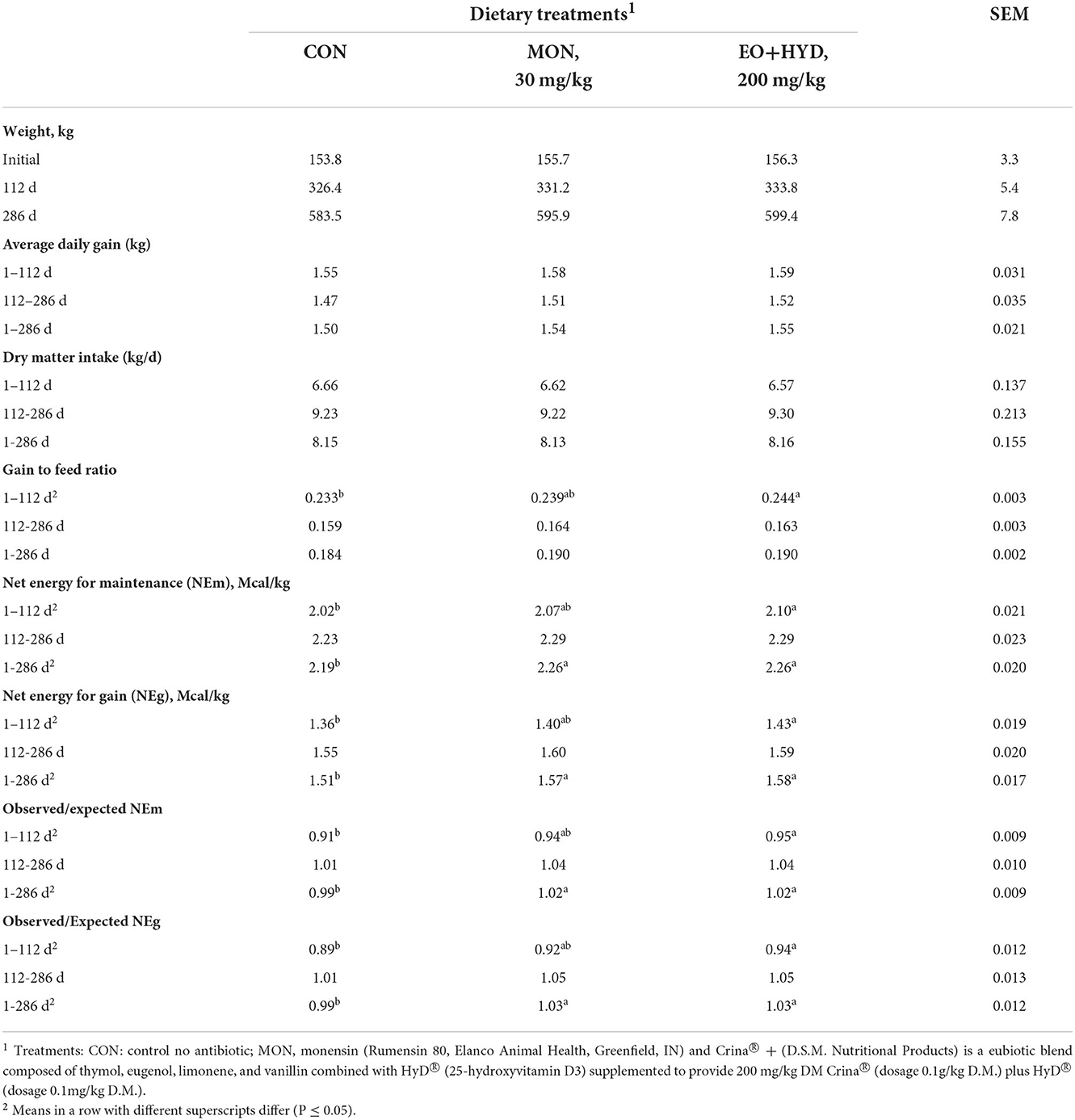
Table 2. Influence of feeding an eubiotic blend of essential oils plus 25-hydroxy-vit-D3 on growth-performance of calf-fed Holstein steers.
The greater results of G/F for EO+HYD vs. CON calves during the initial 112-d feeding period was also reflected by enhanced efficiency of dietary energy utilization (Table 2). Steers supplemented with EO+HYD had greater (P ≤ 0.05) estimated NEm and NEg based on cattle growth performance than cattle fed the control diet. The effects of MON supplementation on the efficiency of energy utilization were intermediate (P > 0.05) to that of CON and EO+HYD treatments. The overall observed vs. expected dietary NEm and NEg were greater for MON and EO+HYD than for CON. Observed NE for steers fed the Control diet was in close agreement with expected (OBS/EXP NEm and NEg were 0.99), whereas estimated dietary NE for steers supplemented with MON or EO+HYD exceeded expectations throughout the feeding period.
Treatment effects on carcass characteristics are shown in Table 3. Calf-fed Holstein steers supplemented with MON had greater fat thickness as measured over the longissimus than EO+HYD supplemented steers, and both were intermediate (P ≥ 0.05) to cattle fed the CON diet. There were no other treatment effects (P > 0.05) on KPH, longissimus area, marbling score, and retail yield. The health status of cattle in the current study, as well as liver abscess and liver scars at slaughter, were similar (P > 0.05) across treatments (Table 3).
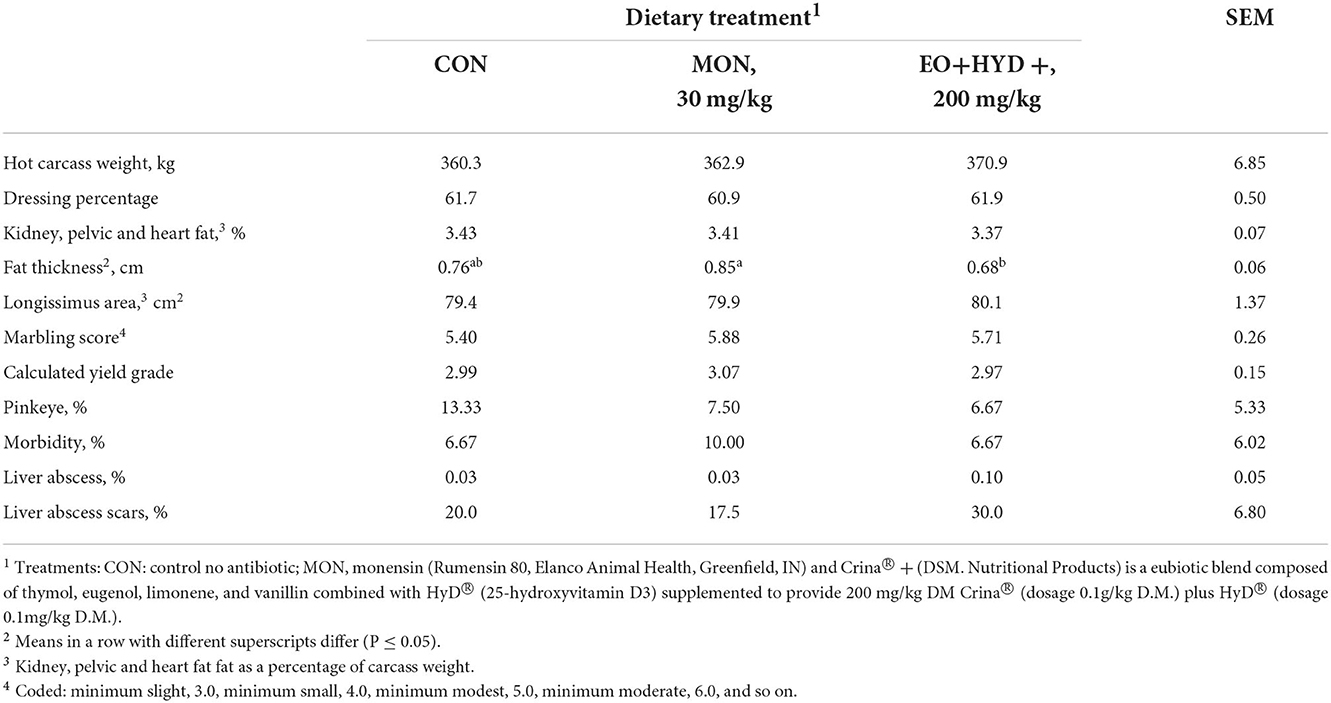
Table 3. Influence of feeding an eubiotic blend of essential oils plus 25-hydroxy-vit-D3 on carcass characteristics and health score of calf-fed Holstein steers.
Monthly average THI and maximum and minimum temperature during the 286-d feeding period are presented in Figure 1. During July and August of 2021, the average THI exceeded 80, an ambient condition classified as “danger” Brown-Brandl et al. (26). Feeding EO+HYD to calf-fed Holstein steers under these ambient conditions decreased (P < 0.05) mean rumenal temperature compared to cattle fed CON or MON diet (Figure 2). There were no major treatment effects on cattle respiration rate (Figure 3). However, it is worth pointing out that regardless of treatment, cattle respiration rate was above “danger” designation (26) during July and August, and were highly correlated with THI measurements.
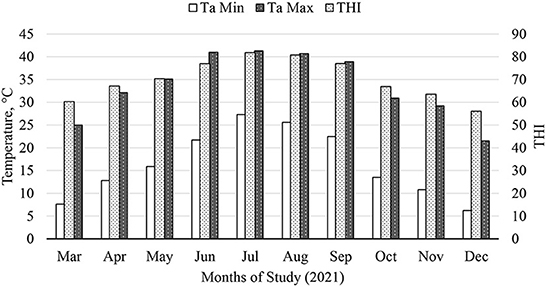
Figure 1. Temperature-humidity index (THI) during the course of the 286-d feeding period: THI = (0.8 × Ta) + [(H/100) × (Ta – 14.4)] + 46.4, where Ta is air temperature (°C) and H is relative humidity (Thom, 1959; NOAA, 1976); Min, minimum; Max, maximum.
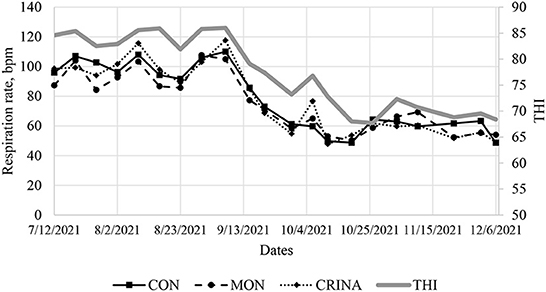
Figure 3. Weekly cattle respiration rate (1,100 h) and temperature-humidity index from July through December.
Discussion
Consistent with the current study (Table 2), Meyer et al. (8) reported that crossbred yearling beef steers fed grain-based diets for 115 days and supplemented with a similar EO had similar overall ADG to the control non-supplmented and MON supplemented diet. However, different than the current experiemnt these authores observed that compared with non-supplemented control and EO supplemented cattle, cattle supplemented with MON decreased DMI, but greater G/F compared to non-supplemtend cattle (8). Meschiatti et al. (9) compared the effects of supplementing EO in a grain-based diet fed to Nellore bulls, and observed that supplemental MON decreased DMI but did not appreciably affect ADG or G/F when compared to diets supplemented with only an EO blend (9). In a similar study, Gouvea et al. (10) observed a similar increase in DMI for cattle supplemented with a blend of EO compared to cattle supplemented with MON, though cattle supplemented with a blend of EO were also supplemented with amylase. Moreover, Toseti et al. (27) observed similar G/F in Nellore bulls fed grain-based diets supplemented with EO or MON. However, authors reported that whereas bulls fed EO had similar DMI, both ADG and final BW were greater for bulls supplemented with EO than for bulls supplemented with MON (27).
Although, results comparing MON vs. EO have been inconsistent. In agreement with the current study (Table 2), Meschiatti et al. (9) and Gouvea et al. (10) observed that cattle fed EO or MON had similar estimated dietary energy utilization, but greater than non-supplemented cattle. Conversely to the current study, Mendoza-Cortéz et al. (28) reported that Zebu-British bulls fed a grain-based diet in high ambient temperature supplemented with EO+HYD had greater efficiency of dietary energy utilization of the diet compared with bulls supplemented with MON. Authors attributed the potential benneficts of supplementing EO+HYD to a greater DMI intake observed in cattle receiving EO+HYD compared to cattle in the MON (28). Moreover, the greater ADG observed by Mendoza-Cortéz et al. (28), could be attributed to potential effect that supplementing HYD would have on net protein retention (lean tissue growth), previous reported in the literature (14). However, in contrast with the present study, none previously mentioned studies had a negative (non-supplemented) control diet.
Consistent with similar studies, there was no effect of MON or EO on major carcass characteristcs (Table 3). In the current study dressing percentage, KPH, longissiumus area, marbling score, or yield grade, though the studies did not include a control diet with no feed additive (8–10). Meschiatti et al. (9) did not observe any difference between EO and MON treatments on the specific carcass characteristics listed, though, conversely to this study, it was reported that cattle had an increased HCW when supplemented with EO + amylase compared to MON. In contrast to similar studies, the current study reported an increase in fat thickness over the longissimus area for cattle supplemented with EO + HyD compared to MON while the control treatment was intermediary. As previously mentioned in the current manuscript, previous research has reported that cattle supplemented with HYD could have greater lean tissue growth due to greater net protein retention (14), this could be the reason for decrease in fat thickness observed in the current study. However, there were no differences among treatments in other major carcass characteristcs. Therefore, authors in the current experiment recommend that more research needs to be conducted to elucidate the effects of EO+HYD on the carcass composition of cattle.
Converse to the current study where authors did not observed treatment effects in percentage of liver abscess or liver abscess scars (Table 3). Meyer et al. (8) reported that cattle supplemented with MON + Tylosin and EO + Tylosin decrease, and cattle supplemented EO alone tended to decrease liver abscess incidence compared to the control (6.5, 8.6, 16.6, and 27.2%, respectively). Although previous research has reported that calf-fed Holstein steers have a greater incidence of liver abscess than native beef breed (29), studies conducted at our laboratory (19, 30) have reported lower incidences (< 10%) of liver abscess in calf-fed Holstein (more characteristic of the southwest desert region in the United States) than previous research. Although, previous research has reported that the majority of respiratory diseases in the feedlot occurred within the weeks days after cattle arrival (31), which may impact cattle growth performance. Therefore, potentially explanning the greater G/F efficiency observed in the first 112 days on feed for cattle supplemented with EO+HYD and MON, compared to non-supplemented cattle. There were no effect of cattle supplementation on pikeye incidence or cattle morbidity in the current study. Moreover, consistent with the present study (Figure 2), Silva et al. (32) also observed that lactating dairy cows supplemented with a blend of EO had reduced frequency of high rectal temperature and increased blood oxygenation. However, more research needs to be conducted to illustrate the mechanism of this potential benefit of EO and EO+HYD to cattle health and confort when animals are raised under high-ambient temperatures.
Conclusion
Supplementation of calf-fed Holstein steers with MON or EO+HYD increases the overall efficiency of dietary net energy utilization for maintenance and gain (3 and 4%, respectively) without major effects on carcass characteristics or liver abscess incidence when fed to calf-fed Holstein steers for over 285 days. Moreover, cattle supplemented with EO+HYD decreased mean reticulorumen temperature when experiencing extremely high ambient temperature.
Data availability statement
The raw data supporting the conclusions of this article will be made available by the authors, without undue reservation.
Ethics statement
All procedures involving animal care and management were in accordance with and approved by the University of California, Davis, Animal Use and Care Committee (protocol # 18811 and 18812).
Author contributions
All authors were involved in study design, data collection, data analysis, manuscript preparation, and approved the submitted version.
Funding
This project was supported through the University of California Agricultural Experiment Station with Hatch funding from the USDA National Institute of Food and Agriculture (CA-D-ASC-6578-H), California Department of Food and Agriculture, and financial contributions from DSM, Inc.
Conflict of interest
The authors declare that the research was conducted in the absence of any commercial or financial relationships that could be construed as a potential conflict of interest.
Publisher's note
All claims expressed in this article are solely those of the authors and do not necessarily represent those of their affiliated organizations, or those of the publisher, the editors and the reviewers. Any product that may be evaluated in this article, or claim that may be made by its manufacturer, is not guaranteed or endorsed by the publisher.
References
1. Samuelson KL, Hubbert ME, Galyean ML, Loest CA. Nutritional recommendations of feedlot consulting nutritionists: The 2015 New Mexico State and Texas Tech University survey. J Anim Sci. (2016) 94:2648–63. doi: 10.2527/jas.2016-0282
2. Goodrich RD, Garrett JE, Gast DR, Kirick MA, Larson DA, Meiske JC. Influence of monensin on the performance of cattle. J Anim Sci. (1984) 58:1484–98. doi: 10.2527/jas1984.5861484x
3. Russell JB, Strobel JH. Effects of additives on in vitro ruminal fermentation: a comparison of monensin and bacitracin, another gram-positive antibiotic. J Anim Sci. (1988) 66:552–8. doi: 10.2527/jas1988.662552x
4. Zinn RA, Plascencia A, Barajas R. performance and digestive function Interaction of forage level and monensin in diets for feedlot cattle on growth. J Anim Sci. (1994) 72:2209–15. doi: 10.2527/1994.7292209x
5. Zinn RA. Influence of lasalocid and monensin plus Tylosin on comparative feeding value of steam-flaked versus dry-rolled corn diets for feedlot cattle. J Anim Sci. (1987) 65:256–66. doi: 10.2527/jas1987.651256x
6. European Commission. Regulation (EC) No. 1831/2003 of the European Parliament and of the Council of 22 September 2003 on Additives for Use in Animal Nutrition. Off J Eur Union. (2003) L:L268/29–43.
7. Cobellis G, Trabalza-Marinucci M, Yu ZT. Critical evaluation of essential oils as rumen modifiers in ruminant nutrition: a review. Sci Total Environ. (2016) 545:556–68. doi: 10.1016/j.scitotenv.2015.12.103
8. Meyer NF, Erickson GE, Klopfenstein TJ, Greenquist MA, Luebbe MK, Williams P, et al. Effect of essential oils, Tylosin, and monensin on finishing steer performance, carcass characteristics, liver abscesses, ruminal fermentation, and digestibility. J Anim Sci. (2009) 87:2346–54. doi: 10.2527/jas.2008-1493
9. Meschiatti MAP, Gouvêa VN, Pellarin LA, Batalha CDA, Biehl MV, Acedo TS, et al. Feeding the combination of essential oils and exogenous α-amylase increases performance and carcass production of finishing beef cattle. J Anim Sci. (2019) 97:456–71. doi: 10.1093/jas/sky415
10. Gouvea VN, Meschiatti MAP, Moraes JMM, Batalha CDA, Dorea JRR, Acedo TS, et al. Effects of alternative feed additives and flint maize grain particle size on growth performance, carcass traits and nutrient digestibility of finishing beef cattle. J Agr Sci. (2019) 1–13. doi: 10.1017/S0021859619000728
11. Patra AK. Effects of essential oils on rumen fermentation, microbial ecology and ruminant production. Asian J Anim Vet Adv. (2011) 6:416–28. doi: 10.3923/ajava.2011.416.428
12. Khiaosa-Ard R, Zebeli Q. Meta-analysis of the effects of essential oils and their bioactive compounds on rumen fermentation characteristics and feed efficiency in ruminants. J Anim Sci. (2013) 91:1819–30. doi: 10.2527/jas.2012-5691
13. Gouvêa VN, Vasconcellos GS, Acedo TS, Tamassia LF. The 25-hydroxyvitamin D3 supplementation improves animal performance of Nellore cattle grazed in tropical grass. J Anim Sci. (2019) 97:161. doi: 10.1093/jas/skz258.331
14. Carvalho VV, Perdigão A. Supplementation of 25-hydroxyvitamin-D3 and increased vitamin E as a strategy to increase carcass weight of feedlot beef cattle. J Anim Sci. (2019) 97:440. doi: 10.1093/jas/skz258.871
15. Acedo TS, Gouvêa VN, Vasconcellos GSFM, Arrigoni M, Martins CL, Millen DD, et al. Effect of 25-hydroxyvitamin-D3 on feedlot cattle. J Anim Sci. (2019) 96:447–8. doi: 10.1093/jas/sky404.977
16. Moore MC, Gray GD, Hale DS, Kerth CR, Griffin DB, Savell JW, et al. National Beef Quality Audit-−2011: In-plant survey of targeted carcass characteristics related to quality, quantity, value, and marketing of fed steers and heifers. J Anim Sci. (2012) 90:5143–5151. doi: 10.2527/jas.2012-5550
17. Boykin CA, Eastwood LC, Harris MK, Hale DS, Kerth CR, Griffin DB, et al. National Beef Quality Audit-2016: In-plant survey of carcass characteristics related to quality, quantity, and value of fed steers and heifers. J Anim Sci. (2017) 95:2993–3002. doi: 10.2527/jas2017.1543
18. Carvalho PHV, Latack BC, Buenabad L, Zinn RA. Influences of implant hormone strategy on growth performance of calf-fed Holstein steers fed in excess of 300 days. Applied Animal Science. (2021) 37:199–206. doi: 10.15232/aas.2020-02123
19. Latack BC, Buenabad L, Carvalho PH, Montano MF, Zinn RA. Influences of timing of liver abscess control and early metabolizable amino acid supplementation on feedlot growth-performance and digestive function of calf-fed Holstein steers. Applied Animal Sci. (2021) 37:533–42. doi: 10.15232/aas.2021-02184
21. USDA. United States Standards for Grading of Carcass Beef. Washington, DC: Agricultural Marketing Service, USDA (1997).
23. Zinn RA, Shen Y. An evaluation of ruminally degradable intake protein and metabolizable amino acid requirements of feedlot calves. J Anim Sci. (1998) 76:1280–9. doi: 10.2527/1998.7651280x
25. NOAA (National Oceanic and Atmospheric Administration). Livestock Hot Weather Stress. Regional Operations Manual Letter C-31–76. Central Region, Kansas City, MO: US Dept Commerce, Natl Weather Serv (1976).
26. Brown-Brandl TM, Eigenberg RA, Nienaber JA, Hahn GL. Dynamic response indicators of heat stress in shaded and non-shaded feedlot cattle, Part 1: Analyses of indicators. Biosyst Eng. (2005) 90:451–62. doi: 10.1016/j.biosystemseng.2004.12.006
27. Toseti LB, Goulart RS, Gouvêa VN, Acedo TS, Vasconcellos GS, Pires AV, et al. Effects of a blend of essential oils and exogenous α-amylase in diets containing different roughage sources for finishing beef cattle. Anim Feed Sci Technol. (2020) 269:114643. doi: 10.1016/j.anifeedsci.2020.114643
28. Mendoza-Cortéz DA, Ramos-Méndez JL, Arteaga-Wences Y, Félix-Bernal A, Estrada-Angulo A, Castro-Pérez BI, et al. Influence of a supplemental blend of essential oils plus 25-hydroxy-vitamin-D3 on feedlot cattle performance during the early-growing phase under conditions of high-ambient temperature. Indian J Anim Res. (2022) 1:6. doi: 10.18805/IJAR.BF-1520
29. Amachawadi RG, Nagaraja TG. Liver abscesses in cattle: a review of incidence in holsteins and of bacteriology and vaccine approaches to control in feedlot cattle. J Anim Sci. (2016) 94:1620–32. doi: 10.2527/jas.2015-0261
30. Carvalho PHV, Latack BC, Flores R, Montano MF, Zinn RA. Interaction of early metabolizable protein supplementation and virginiamycin on feedlot growth performance and carcass characteristics of calf-fed Holstein steers. Transl Anim Sci. (2022) 6:1–6. doi: 10.1093/tas/txab228
31. Hollis LC. Investigating Feedlot Respiratory Disease Outbreaks, Chapter 128 - Food Animal Practice (Fifth Edition),ed. W.B. Saunders (2009). p. 673–6.
Keywords: essential oil, monensin, cattle, feedlot, Holstein
Citation: Latack BC, Carvalho PHV and Zinn RA (2022) The interaction of feeding an eubiotic blend of essential oils plus 25-hydroxy-vit-D3 on performance, carcass characteristics, and dietary energetics of calf-fed Holstein steers. Front. Vet. Sci. 9:1032532. doi: 10.3389/fvets.2022.1032532
Received: 30 August 2022; Accepted: 15 November 2022;
Published: 01 December 2022.
Edited by:
Bangyuan Wu, China West Normal University, ChinaReviewed by:
Flavio Santos, University of São Paulo, BrazilYosra Ahmed Soltan, Alexandria University, Egypt
Copyright © 2022 Latack, Carvalho and Zinn. This is an open-access article distributed under the terms of the Creative Commons Attribution License (CC BY). The use, distribution or reproduction in other forums is permitted, provided the original author(s) and the copyright owner(s) are credited and that the original publication in this journal is cited, in accordance with accepted academic practice. No use, distribution or reproduction is permitted which does not comply with these terms.
*Correspondence: Pedro H. V. Carvalho, cGNhcnZhbGhvQHVjZGF2aXMuZWR1
 Brooke C. Latack1
Brooke C. Latack1 Pedro H. V. Carvalho
Pedro H. V. Carvalho Richard A. Zinn
Richard A. Zinn